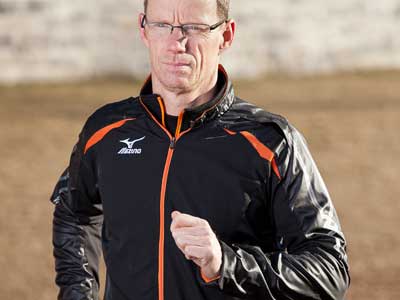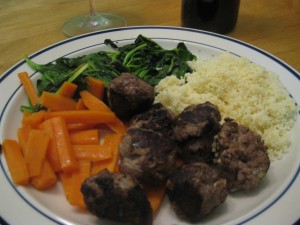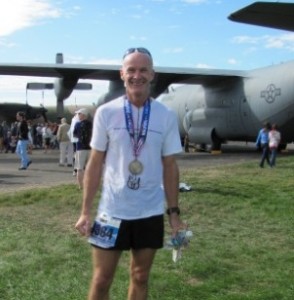
By: Rick Hellard
There has been a lot, and I mean a lot, of chatter about running form in recent years. Most of it has centered on “to be shod or not to be shod,” with off-shoot topics discussing foot plant and proper cadence. However important these topics may be, I would like to discuss another aspect of running form: the arm swing.
The arm action counter-balances the leg action. According to Newton’s Law of Physics (the original guy, not the running shoe company) for every action, there is an equal and opposite reaction. So, when we run or walk, the force of the arms swing creates an equal and opposite reaction in the opposing leg. As a result, the more forcefully we swing the arm backwards, the more forcefully the opposite leg drives forward, and therefore the more ground is covered in each stride. If you want your right leg to drive forward to increase both speed and stride length, drive the left elbow and arm backwards slightly more forcefully. The right leg will move forward more quickly to counterbalance the left arm action and the momentum will carry the leg further forward. It will work every time.
I’ve participated in running clinics where the instructors tried to simplify the arm swing topic with an analogy. Unfortunately, due to individual perceptions, those analogies often are not quite interpreted the way they were intended, and the result can be an even more awkward and less efficient arm swing. Phrases like “imagine pulling yourself up the hill,” or “your hands and arms should go straight forward and backward like the rails on train wheels,” or even, “focus on swinging your hands forward to reach up the road or hill” can be misinterpreted. These analogies are not wrong, they are just not quite right either.
Instead of using analogies to describe proper running form, I have always believed that in watching the best in the world run, we can be directed towards running the best way.
If you watch the best runners in the world, you will notice their arms are bent between 70 and 80 degrees when in front, hands just above sternum height, 15 cm away from the chest plate, and close to—but not crossing—the centre line of the body. The faster they run, the harder the backward arm swinging motion is. At the back end of the arm swing, the arm angle opens to 80-90 degrees.
Keep in mind Archimedes’ wisdom (he’s the guy who said “with a big enough lever, I could move the world”): a long lever has lot of strength. Conversely, a shorter lever must travel more quickly and further to do the same work in the same time frame. In the case of the arm, the hand on the arm bent at 70 degrees is closer to the body than the hand on the arm bent at 80 degrees. Effectively, the lever is shorter at the beginning and lengthens through the arm swing, even if just slightly. The arm can therefore accelerate and move more quickly at the beginning of the arm swing and then halfway through when the arm angle opens up a bit. And this built up momentum adds more force to the longer arm. The opposite leg must, in turn, respond to this force by moving quickly and forcefully forward.
Additionally, though it is subtle, as running pace increases, the height of the hands in front of the body increases. At a light run, the hands are at the sternum. At race pace hands rise about 2 cm higher, and in the final sprint, the hands can be higher still. A slightly higher hand position gives more travel distance to crank the arms backward and gain even more speed and momentum.
You should also notice that the fastest runners keep their shoulders fairly steady (not perfectly steady, just fairly steady) and swing the elbow backwards more than the arm.
A very simple running drill for arm swing mechanics is to sit on the ground with legs straight out in front and swing your bent arms as if you were running. Your hands should travel from about 5 cm outside the centre line of the body and just above sternum height in front to about the hips on the back swing (not behind the body).
Do this for a few minutes to get a feel for it, coming close to your legs without touching them or without rocking your shoulders very much. A mirror helps tremendously with this drill.
So what’s the Oops Factor here?
When it comes to running form, the Oops is believing that there is only one way to run and that that way will work for everyone. There are far too many physical and mental variables between humans to say that one arm position will work for everyone. In watching the best runners, you will notice that none of them has exactly the same form. To that end, my points are only guidelines. Don’t aim for perfection; aim to just get close to doing things within the parameters outlined.
And to reinforce my point about the importance of form, you may also have noticed in watching the lead runners that while the race leaders all have GOOD form, the winner does not always have the BEST form.










 Our Magazine
Our Magazine
